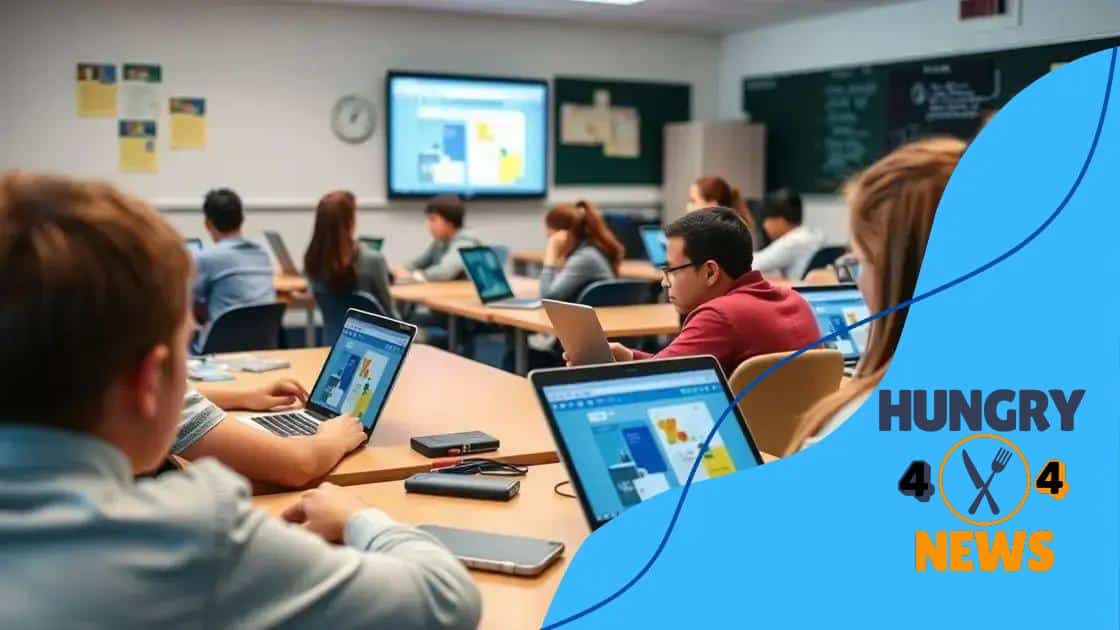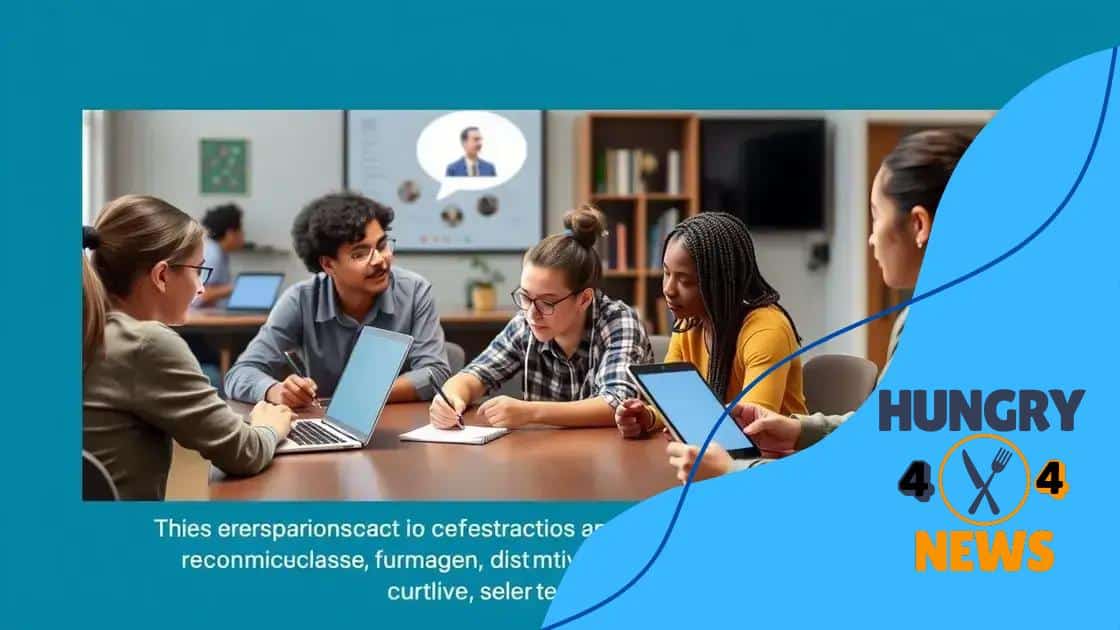Remote learning technology for post-pandemic education

Remote learning technology for post-pandemic education enhances accessibility and engagement through tools like AI and VR, enabling personalized and interactive learning experiences for students globally.
Remote learning technology for post-pandemic education has become essential for students and teachers alike. Have you ever wondered how these innovations are changing traditional classrooms?
The evolution of remote learning technology
The evolution of remote learning technology has transformed education dramatically. With the rise of the internet and mobile devices, learning has become more accessible. Students can now engage in virtual classrooms from anywhere in the world, making education flexible and inclusive.
Key Milestones in Remote Learning Technology
Remote learning has come a long way. From early correspondence courses to today’s immersive virtual classrooms, several milestones have shaped this landscape. These advancements have paved the way for better engagement and understanding.
- Introduction of the internet in the 1990s, which laid the foundation for online education.
- Development of e-learning platforms that allow interactive learning.
- Growth of video conferencing tools like Zoom and Google Meet.
- Incorporation of virtual reality (VR) for enhanced learning experiences.
Technology has also provided tools for educators. Interactive whiteboards, learning management systems (LMS), and educational apps enable teachers to deliver content effectively. These advancements allow for personalized learning experiences, catering to the needs of different students.
The Role of Artificial Intelligence
Artificial intelligence is becoming a significant part of remote learning technology. By analyzing student performance, AI can provide insights and adapt the curriculum accordingly. For instance, AI-driven platforms can identify areas where a student is struggling and recommend resources to help them improve.
Moreover, chatbots and virtual assistants are available 24/7, enhancing the learning experience by providing immediate answers to students’ queries. This level of accessibility ensures that students receive the support they need, whenever they need it.
As we look to the future, it’s clear that remote learning technology will continue to evolve. Innovations in connectivity and advancements in technological tools will likely create even more opportunities for education, making learning an integral part of our daily lives.
Key tools enhancing remote education
Several key tools enhancing remote education play a vital role in facilitating effective online learning. These tools help both educators and students to interact meaningfully, making the most of the educational experience.
Essential Platforms for Online Learning
Online learning platforms are at the forefront of this transformation. They enable the delivery of content, communication, and assessment in a cohesive manner. Popular platforms include:
- Google Classroom: A user-friendly platform that integrates with other Google services, allowing assignment sharing and feedback.
- Moodle: An open-source learning management system that offers customizable features for different educational needs.
- Edmodo: Combines social media with education, creating a collaborative learning environment.
- Canvas: A flexible LMS that supports various content formats and encourages student engagement.
These platforms are essential for creating a structured learning environment. They offer a centralized location for all course materials, making it easy for students to track their progress.
Interactive Learning Tools
Beyond platforms, several interactive learning tools enrich the remote education landscape. These tools promote student engagement and facilitate a deeper understanding of concepts.
Applications like Kahoot! make learning fun by adding gamification elements. Students can participate in quizzes and challenges that reinforce their learning. Furthermore, tools like Nearpod allow teachers to create interactive presentations that students can engage with in real time.
In addition, whiteboard tools such as Jamboard help visualize ideas and concepts during online lessons. This interactive feature is particularly helpful in subjects like math and science, where visual aids can significantly enhance comprehension.
As education continues to evolve, these tools will enhance how we teach and learn, making remote education not just a necessity but a rich and engaging experience.
Challenges faced by educators and students

Remote learning has introduced several challenges faced by educators and students. While technology offers many benefits, it also presents obstacles that can hinder the learning process.
Technical Issues and Accessibility
One of the primary challenges for many is the lack of reliable internet access. Not all students have the same level of connectivity, which can lead to disparities in learning. Many schools are attempting to address these issues by providing resources like Wi-Fi hotspots and devices.
- Some students struggle with low bandwidth at home, making joining live classes difficult.
- Inadequate hardware can limit participation in online activities.
- Learning management systems may be challenging to navigate for both students and educators.
Additionally, technology can sometimes fail during critical moments. Unexpected outages or slow connections can interrupt lessons and cause frustration.
Engagement and Motivation
Another significant challenge is maintaining student engagement. In a regular classroom, teachers can create an interactive environment that captivates their students. However, in a remote setting, it is easy for students to become distracted.
Without the physical presence of peers and teachers, motivation can decline. To combat this, educators must employ various strategies, such as:
- Using interactive content to keep the lessons fresh and engaging.
- Encouraging student participation through discussions and polls.
- Creating smaller group sessions to foster personal connections.
Effective communication is vital. Students may feel isolated when learning from home, which can impact their mental health. Teachers must be proactive in reaching out and providing support. This can be achieved through regular check-ins, feedback, and fostering a sense of community.
It is essential for educators and institutions to adapt to these challenges. Finding innovative solutions will not only enhance the current educational experience but also help create a more resilient system for the future.
Effective strategies for successful online learning
Implementing effective strategies for successful online learning is crucial for enhancing student engagement and understanding. With the right approaches, both educators and students can thrive in a virtual classroom setting.
Creating a Structured Learning Environment
One of the first steps is to establish a clear structure for the online learning experience. This includes setting specific times for classes, creating a syllabus, and outlining expectations. A consistent schedule helps students stay organized and focused.
- Provide a clear agenda before each class.
- Encourage students to keep a dedicated learning space, free from distractions.
- Use a variety of teaching methods to cater to different learning styles.
By fostering a structured environment, students feel more secure and can concentrate better on their studies.
Encouraging Active Participation
Active participation is key to online learning success. Educators can promote this by incorporating various interactive tools and techniques into their lessons.
Using polls, breakout rooms, and discussion forums invites students to share their thoughts and engage with each other. This interaction builds a sense of community and keeps students motivated. Techniques such as:
- Incorporating breakout sessions for group work.
- Utilizing quizzes and real-time feedback to gauge understanding.
- Encouraging students to ask questions and share insights during lessons.
This kind of engagement makes learning more enjoyable and effective.
Additionally, providing timely feedback is essential. Regular check-ins and constructive criticism help students stay on track. Providing praise when they perform well boosts their confidence and encourages further participation.
To enhance learning outcomes, educators should also utilize various multimedia resources. Incorporating videos, podcasts, and interactive simulations helps make complex concepts more understandable. Blending these elements into lessons can cater to different preferences and lead to deeper learning experiences.
The future of education with remote technology
The future of education with remote technology is shaping up to be both exciting and transformative. As technology continues to evolve, so do the methods by which students learn and educators teach. The integration of advanced technologies is already enhancing the learning experience.
Emerging Technologies in Education
Future classrooms will likely leverage cutting-edge technologies such as artificial intelligence (AI) and virtual reality (VR). These tools can provide immersive learning experiences, making complex subjects more engaging.
- Artificial Intelligence: AI can personalize learning by adapting to each student’s pace and style. It can analyze performance data to provide recommendations.
- Virtual Reality: VR can transport students to different places and times, offering experiential learning opportunities that textbooks cannot provide.
- Augmented Reality: This technology overlays digital content on the real world, enhancing lessons in science, history, and even art.
These emerging trends demonstrate that the future of remote education will focus on personalization and engagement.
Global Learning Opportunities
Remote technology will also open up global learning opportunities. Students from various parts of the world can connect and collaborate on projects. This promotes cultural exchange and enhances critical thinking skills.
Imagine a student in Brazil working on a science project with peers in Japan, all through video conferencing and collaborative platforms. This level of interaction encourages a broader understanding of global issues and diverse perspectives.
As technology continues to advance, we can expect to see more innovative solutions that address the needs of diverse learners. Online courses will become more accessible, allowing more students to benefit from quality education regardless of their location.
Furthermore, educators will need to adapt their teaching methods to encompass these new tools. Continuous professional development and training will ensure that teachers are effective in utilizing technology to enhance learning outcomes.
In summary, the future of education with remote technology promises to break down barriers and create a more inclusive and engaging learning environment for all.
In conclusion, the landscape of education is rapidly changing due to remote technology. As we have seen, these technologies are providing new opportunities for both students and educators. By embracing tools like AI and VR, we can create more engaging and personalized learning experiences. The future of education is bright, with global connections and diverse resources making learning accessible to everyone. It’s essential to adapt to these changes and ensure that all students benefit from these advancements.
FAQ – Questions about the Future of Education with Remote Technology
What technologies are transforming remote education?
Technologies like artificial intelligence (AI) and virtual reality (VR) are reshaping how students learn and engage in online classrooms.
How does remote education promote global collaboration?
Remote education enables students from different countries to collaborate on projects, sharing diverse perspectives and ideas.
In what ways can learning be personalized in remote education?
Remote education can be personalized through adaptive learning platforms that cater to individual student needs and learning styles.
What are the main benefits of remote learning?
The main benefits include increased accessibility, flexibility in learning schedules, and the ability to utilize a wide range of resources and tools.





